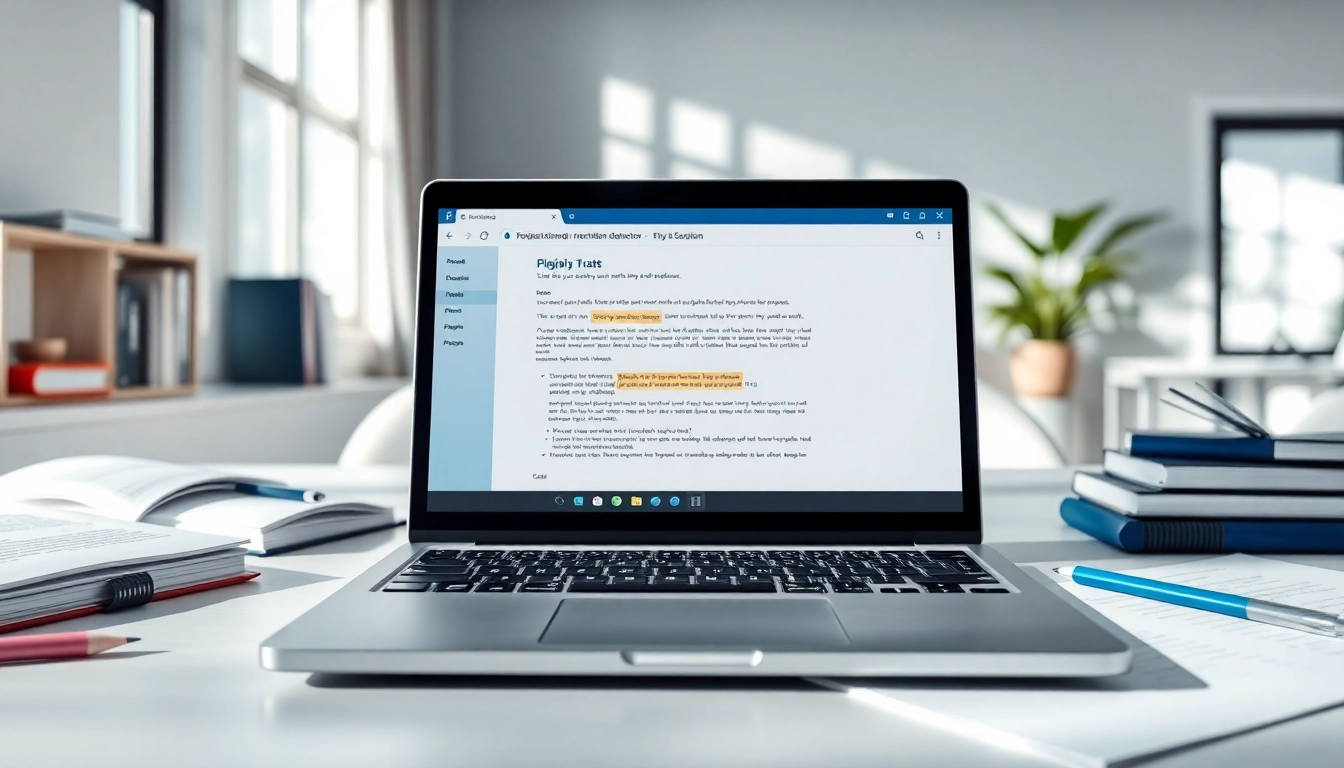Understanding Plagiarism and Its Consequences
What is Plagiarism?
Plagiarism refers to the act of using someone else’s work, ideas, or intellectual property without proper attribution, presenting it as one’s own. This can encompass anything from copying text directly to paraphrasing without acknowledgment, and even the use of multimedia elements such as images, videos, and music. In academic contexts, plagiarism is considered a serious ethical violation that undermines the integrity of scholarly work.
Types of Plagiarism
Understanding the different forms of plagiarism is crucial for students and writers alike. Here are the main types:
- Direct Plagiarism: Copying text word-for-word from a source without citation.
- Self-Plagiarism: Reusing one’s own previously submitted work without permission or citation.
- Patchwork Plagiarism: Combining text from several sources and presenting it as original work.
- Accidental Plagiarism: Failing to cite sources inadvertently, often due to lack of knowledge about citation practices.
Consequences of Plagiarism in Academia
The consequences of plagiarism can be severe. In an academic environment, students caught plagiarizing may face disciplinary actions, including failing grades, expulsion, or the loss of academic privileges. Beyond immediate penalties, plagiarism can damage a student’s reputation and hinder future educational or career opportunities. Educational institutions take plagiarism seriously because it not only discredits individuals but undermines the value of the institution itself.
The Importance of Using a Plagiarism Detector
Benefits of Regular Plagiarism Checks
Utilizing a plagiarism detector is essential for anyone wanting to maintain academic integrity. Regular checks help ensure that your work is original and appropriately cited, preventing the accidental inclusion of plagiarized content. Other benefits include:
- Improved Writing Skills: Analyzing plagiarism reports can enhance your understanding of proper citation and paraphrasing techniques.
- Better Research Practices: Frequent use of these tools encourages thorough research and careful note-taking, leading to higher-quality work.
- Stress Reduction: Knowing your work is free of plagiarism can significantly reduce anxiety associated with submission deadlines.
How Plagiarism Detectors Work
Plagiarism detection tools utilize advanced algorithms to scan documents against vast databases of published works, academic papers, and online content. The software identifies similarities between the submitted text and existing sources, flagging potential instances of plagiarism. These tools often provide a similarity score and highlight matched sections, making it easier for users to revise their work accordingly.
Best Practices for Using a Plagiarism Detector
To maximize the effectiveness of plagiarism detection tools, users should keep several practices in mind:
- Run Checks Early: Use a plagiarism detector during the drafting phase to ensure originality from the outset.
- Review Detected Matches: Not all flagged content indicates plagiarism. Review the results critically to assess whether citations are needed.
- Integrate Feedback: Make necessary adjustments based on the plagiarism report before finalizing the document.
Choosing the Right Plagiarism Detector for Your Needs
Criteria for Evaluation
When selecting a plagiarism detector, consider several key factors to ensure you choose the right one for your needs:
- Database Size: A larger database increases the likelihood of detecting instances of plagiarism.
- Accuracy: Look for tools known for their precision in identifying copied content.
- User Interface: An intuitive design can enhance the user experience and streamline the detection process.
- Speed: Some detectors are faster than others; choose one that fits your timeline for document review.
Top Features to Look For
The best plagiarism detectors come equipped with various features to enhance their utility:
- Detailed Reports: A good tool should provide comprehensive reports detailing the extent and nature of detected plagiarism.
- Multiple Document Formats: Support for various file types (e.g., Word, PDF, etc.) ensures flexibility in use.
- Real-Time Scanning: Some tools offer instant results that allow for on-the-spot checks.
- Customization: The ability to set specific parameters for checks, like excluding certain types of content, can be beneficial.
Comparing Popular Plagiarism Detectors
Several popular plagiarism detection tools dominate the market, each with its own strengths and weaknesses:
- Turnitin: Widely recognized in academia, offers in-depth analysis but may be more appropriate for institutional use.
- Grammarly: Beyond grammar checking, it includes a reliable plagiarism checker suitable for students and professionals.
- PapersOwl: Known for its user-friendly interface and effectiveness in academic settings, offering quick scans and accurate results.
- DupliChecker: A free tool that provides basic plagiarism detection, good for one-off checks but limited in advanced capabilities.
How to Effectively Use a Plagiarism Detector
Step-by-Step Guide for Users
To ensure optimal use of a plagiarism detector, follow this straightforward guide:
- Prepare Your Document: Ensure that your text is complete and formatted correctly for the plagiarism checker you are using.
- Select the Tool: Choose a plagiarism detector that meets your needs based on the criteria outlined earlier.
- Upload Your Document: Follow the specified instructions to upload your work, whether by copy-paste or file upload.
- Review Results: After scanning, carefully analyze the results, focusing on highlighted sections and the similarity score provided.
- Revise Your Work: Make necessary changes to ensure your document is original and properly cited before submitting.
- Save Your Report: If applicable, save the plagiarism report for your records or for submission alongside your work.
Common Pitfalls to Avoid
Using plagiarism detectors can yield misleading conclusions if users are unaware of common pitfalls. Here are a few to watch out for:
- Ignoring Citations: Just because a tool flags content doesn’t make it plagiarized—ensure proper citations are in place.
- Reliance on One Tool: Different tools have distinct databases and algorithms; cross-checking results can provide a more accurate picture.
- Failure to Update: Make sure your plagiarism detectors are up-to-date to benefit from improvements in their algorithms and databases.
Interpreting the Results from a Plagiarism Detector
Understanding the results provided by a plagiarism detector is essential to effectively revising your work. Key aspects to focus on include:
- Similarity Score: This percentage indicates how much of your content overlaps with existing works and is a key indicator of potential issues.
- Highlighted Sections: Pay attention to the specific areas flagged by the tool, as these indicate where rephrasing or citation is required.
- Source Attribution: Look at the sources suggested by the tool for additional context to make informed decisions about revisions.
Future Trends in Plagiarism Detection Technology
The Role of AI in Plagiarism Detection
As technology evolves, AI is playing an increasingly significant role in plagiarism detection. Future developments may include:
- Enhanced Learning Algorithms: AI-powered tools will likely become smarter, adapting to detect subtleties in writing style and structure more effectively.
- Advanced Contextual Analysis: Future tools may better understand context, making it possible to differentiate between legitimate parallels and instances of plagiarism.
Emerging Features in Plagiarism Detectors
Expect future plagiarism detectors to incorporate features that increase usability and precision, such as:
- Integration with Writing Software: Seamless incorporation into word processors could streamline the writing process, alerting users to potential issues as they write.
- Real-Time Collaboration: Tools that allow collaborative checking could become a necessity for academic environments fostering teamwork.
- Customization Based on Discipline: Tailoring plagiarism checks for specific fields could lead to more accurate results, as writing conventions can vary widely
Enhancing User Experience in Plagiarism Detection
User experience is paramount in any technological tool, including plagiarism detectors. Future improvements could include:
- Mobile Accessibility: Enhancing functionality for mobile users will ensure that checks can be performed anytime, anywhere.
- Interactive Tutorials: Providing users with guided experiences and learning resources can help them understand how to utilize the tool effectively.
- Feedback Integration: Systems allowing user feedback to improve tool accuracy and features will foster user trust and engagement.




